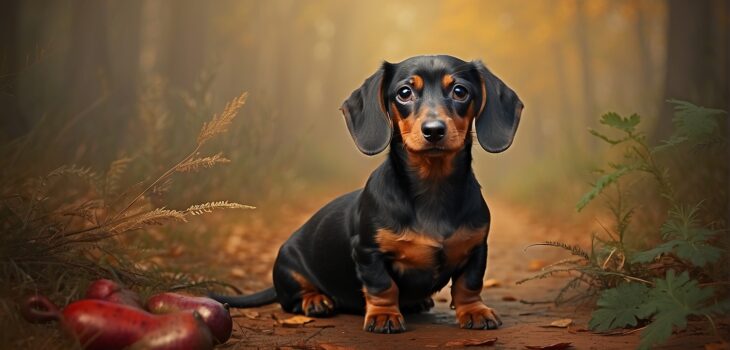Did you know that the adorable and petite Dachshunds we see today were actually bred to be fierce hunters? The Hunting Origins of Dachshunds unveils the fascinating history behind these charming canines. With their elongated bodies and energetic nature, these dogs were originally developed in Germany to hunt badgers and other burrowing animals. Join us on a journey to uncover the hidden world of the Dachshunds’ hunting instincts and how they’ve evolved into beloved companion pets.
Introduction to Dachshunds
Dachshunds, also known as “wiener dogs,” are a beloved dog breed that has captured the hearts of many pet owners around the world. With their distinct long bodies and short legs, they certainly stand out from the crowd. In this article, we will explore the origins, development, and hunting skills of Dachshunds, shedding light on their fascinating history and the unique traits that make them such remarkable creatures.
Overview of the Dachshund breed
Dachshunds are a small to medium-sized breed originally from Germany. They were bred to hunt and track down burrow-dwelling animals, such as badgers and rabbits. Today, however, they are more commonly seen as family pets due to their affectionate nature and lively personality. Dachshunds come in different coat types, including smooth, wirehaired, and longhaired, each with its own distinct appearance and charm.
Appearance and physical characteristics of Dachshunds
One of the defining features of Dachshunds is their unique body shape. Their elongated bodies and short legs were specifically designed to allow them to navigate through narrow underground tunnels. Despite their compact stature, Dachshunds have a well-muscled chest and strong front legs, which contribute to their impressive endurance and agility. Their expressive eyes and floppy ears add to their undeniable appeal, making them truly iconic in the dog world.

Popularity of Dachshunds as pets
Dachshunds have gained immense popularity as pets around the globe. Their cheerful and playful nature make them wonderful companions for individuals and families alike. Due to their small size and adaptability, they are well-suited for apartment living, making them an ideal choice for many urban dwellers. Additionally, their loyalty and affection towards their owners are unrivaled, leaving no doubt as to why Dachshunds are consistently ranked among the top breeds in terms of popularity.
German origins of the Dachshund breed
The Dachshund breed originated in Germany several centuries ago. The name “Dachshund” itself translates to “badger dog” in English, indicating their original purpose as skilled hunters of badgers and other burrow-dwelling animals. German breeders specifically developed Dachshunds to track, chase, and retrieve prey from underground tunnels. Their innate hunting instincts and tenacity set them apart, making them highly prized for their hunting abilities throughout history.
Historical context and timeline
The history of Dachshunds can be traced back to as early as the 15th century. During that time, badger-baiting was a common practice in Europe, and the need for a specialized hunting dog arose. Selective breeding programs were established to create a breed that excelled in hunting underground. Throughout the centuries, Dachshunds proved to be invaluable in the hunting community, with their breeding and popularity continuing to grow.
Purpose and use of Dachshunds
Dachshunds were primarily bred for hunting purposes. Their remarkable scent tracking abilities, agility, and determination made them well-suited for the task of hunting burrow-dwelling animals. They would tirelessly chase their prey into their dens, using their long and low bodies to maneuver through tight spaces. Dachshunds were often used in packs, as their teamwork and communication skills proved to be particularly effective. In addition to hunting, Dachshunds were also valued for their companionship and loyalty to their owners.

Selective breeding and early ancestors
The development of Dachshunds involved selective breeding over many generations, aimed at producing dogs with the desired traits for hunting. They were primarily bred from other hunting breeds, such as the Basset Hound and the Pinscher. These early ancestors contributed to the distinctive long body shape, scent tracking abilities, and strong hunting instincts that are characteristic of Dachshunds today.
Influence of larger hunting breeds
While Dachshunds are small in size, they possess many characteristics of larger hunting breeds. The influence of these larger breeds, such as Bloodhounds and Pointers, can be seen in their exceptional scent tracking abilities. Coupled with their determination and agility, Dachshunds were able to excel in hunting tasks that were traditionally performed by larger dogs.
Variations in coat types and sizes
One notable aspect of the Dachshund breed is the variety of coat types and sizes available. Smooth-coated Dachshunds have short and sleek fur, while wirehaired Dachshunds have a coarse and rough coat. Longhaired Dachshunds, on the other hand, have a soft and flowing coat. These variations in coat types add to the visual diversity of the breed, making each Dachshund unique in its own way. Furthermore, Dachshunds come in different sizes, including standard, miniature, and toy, providing options for individuals with various preferences and living situations.
Natural instinct for scent tracking
Dachshunds possess an innate and remarkable talent for scent tracking, inherited from their hunting ancestors. Their highly sensitive noses allow them to pick up even the faintest of scents, enabling them to trail and locate their prey. This natural instinct for scent tracking is deeply ingrained in Dachshunds and is one of the key factors that make them exceptional hunting dogs.
Ability to go to ground and locate prey
One of the defining characteristics of Dachshunds is their ability to “go to ground.” This term refers to their capability to enter underground burrows and tunnels in pursuit of their prey. Despite their small size, Dachshunds are fearless and determined when it comes to hunting. Once they locate their prey, they use their sharp claws and strong jaws to dig and navigate through the earth, ultimately reaching their target.
Specialized body shape and features for hunting
The unique body shape and features of Dachshunds were specifically adapted for hunting purposes. Their long, elongated bodies allowed them to move through narrow tunnels and burrows with ease. Additionally, their powerful chests and strong front legs provided them with the strength and stamina necessary to pursue and capture their prey. These specialized adaptations have been honed over generations of selective breeding, resulting in a well-adapted breed with remarkable hunting skills.
Common game hunted by Dachshunds
Dachshunds were primarily used to hunt game such as badgers, rabbits, and foxes. Their tenacity and determination made them excellent hunters, capable of quickly and efficiently tracking down their prey. Badgers, in particular, presented a formidable challenge for Dachshunds, as they are known for their strength and aggression when cornered. Although initially bred for badger hunting, Dachshunds were versatile enough to adapt to hunting various other game.
Rats, badgers, and other burrow-dwelling animals
Apart from badgers, Dachshunds were also utilized for hunting smaller burrow-dwelling animals, such as rats and rabbits. These animals often inhabited complex underground networks that required the skills of a determined and agile hunter like the Dachshund. Their ability to squeeze into tight spaces and their natural instinct for tracking proved invaluable when pursuing these elusive creatures.
Hunting in different terrains and environments
Dachshunds were versatile hunters and could adapt to various terrains and environments. Whether it was dense forests, open fields, or rocky hillsides, Dachshunds were able to navigate these terrains with ease. Their agility and determination allowed them to pursue their prey across different landscapes, making them valuable assets in the hunting world.
Basic training commands and obedience
Training a Dachshund for hunting required a solid foundation in basic training commands and obedience. Commands such as “sit,” “stay,” and “come” were crucial in maintaining control and ensuring that the dog followed the hunter’s instructions. This basic training was essential for establishing a strong bond between the hunter and the Dachshund and creating a productive and successful hunting team.
Specific hunting training techniques
In addition to basic obedience training, specific hunting training techniques were employed to enhance the Dachshund’s hunting skills. These techniques involved teaching the dog to track scents, recognize prey, and retrieve hunted game. Exercises focused on honing the Dachshund’s natural instincts and maximizing its potential as a hunting partner. Consistent and patient training played a vital role in developing the dog’s abilities and turning it into a reliable hunting companion.
Working with Dachshunds as scent hounds
Dachshunds excel as scent hounds, relying on their acute sense of smell to track and locate prey. Working with Dachshunds as scent hounds required a keen understanding of their capabilities and limitations. Hunters needed to provide appropriate opportunities for the Dachshund to exercise its scent tracking skills, allowing it to use its nose to its full potential. By understanding and embracing their role as scent hounds, Dachshunds could truly shine in their hunting endeavors.
Long and low body shape
The distinct long and low body shape of Dachshunds is a direct result of selective breeding for hunting. This body shape allowed Dachshunds to maneuver through narrow tunnels and burrows effortlessly. Their elongated bodies also provided them with increased flexibility, granting them an advantage when chasing prey in tight spaces. This unique physique remains a prominent characteristic of Dachshunds today, serving as a reminder of their valuable hunting origins.
Powerful chest and front legs
Despite their small size, Dachshunds have surprisingly powerful chests and front legs. This strength is essential for their hunting endeavors, as it allows them to dig and navigate through the earth when pursuing their prey. The well-muscled chest provides the necessary support for their front legs, enabling them to perform their hunting duties with utmost efficiency and endurance.
Protective features for hunting underground
Dachshunds possess several protective features that are advantageous for hunting underground. Their sturdy skin and loose outer coat act as a shield, protecting them from potential injuries or bites while navigating through burrows. Additionally, their long muzzle assists in digging and exploring, allowing them to efficiently search for their quarry underground. These protective features were crucial for the safety and well-being of the Dachshund while engaging in its hunting pursuits.
Team hunting with packs of Dachshunds
In some hunting scenarios, Dachshunds were used in packs, working collaboratively to maximize their effectiveness. The synergy between the Dachshunds heightened their tracking abilities, as they could cover larger areas and share scent information with one another. This team hunting strategy further showcased the cooperative nature of the breed and their ability to work together to achieve a common goal.
Hunting in small groups or individually
While team hunting was a common practice, Dachshunds were also known to hunt in small groups or as individuals. With their exceptional scent tracking skills and tenacity, Dachshunds were capable of hunting effectively on their own. This versatility allowed them to adapt to different hunting situations, proving that their skills were not solely reliant on being part of a larger pack.
Collaboration with other hunting breeds
Dachshunds often collaborated with other hunting breeds to enhance their hunting capabilities. These collaborations were particularly common when hunting larger game, where the assistance of other breeds specialized in specific tasks was invaluable. Dachshunds’ compatibility with other breeds further exemplified their versatile nature and their ability to work alongside different hunting partners.
Shift in Dachshunds’ role from hunting to companionship
Over time, the role of Dachshunds transitioned from hunting to companionship. With the advent of modern hunting methods and changes in society, the demand for hunting Dachshunds decreased. However, their charming personalities and attractive appearance led to an increased interest in keeping them as pets. Dachshunds’ transition from hunters to cherished companions showcased their adaptability and their ability to thrive in different roles.
Selection for temperament and adaptability
As Dachshunds evolved into companion dogs, breeders began to focus on selecting for desirable temperaments and adaptability. Today’s Dachshund is known for its friendly and affectionate nature, making it an excellent family pet. Their adaptable nature allows them to fit into various living environments, whether it be in an apartment or a spacious house. This selection for temperament and adaptability ensures that Dachshunds continue to thrive as beloved pets.
Modern challenges facing hunting Dachshunds
While Dachshunds are no longer predominantly used for hunting, there are still some individuals and organizations that maintain an interest in preserving their hunting abilities. The challenge lies in maintaining the breed’s natural instincts and abilities, as well as finding suitable opportunities for Dachshunds to engage in their innate hunting behaviors. Efforts are underway to provide avenues for Dachshunds to participate in activities such as scent tracking trials and earth dog trials, which allow them to showcase their hunting skills.
Appreciating the hunting origins of Dachshunds
Understanding the hunting origins of Dachshunds helps us appreciate their unique qualities and characteristics. Their hunting instincts and natural abilities set them apart from other breeds and contribute to their overall exceptional charm. Recognizing and honoring the breed’s heritage allows us to have a deeper appreciation for the Dachshund’s role in history and the remarkable qualities they possess.
Maintaining the breed’s unique qualities
Preserving the unique qualities of the Dachshund breed is essential to its continued success and popularity. Breeders and enthusiasts carefully consider the breed standard when breeding Dachshunds, ensuring that the physical and behavioral traits that make them special are preserved. By maintaining the breed’s unique qualities, future generations can continue to enjoy the companionship and joy that Dachshunds bring.
The enduring legacy of hunting Dachshunds
While the hunting abilities of Dachshunds may not be as prominent today, their legacy as skilled hunters lives on. The passion and dedication of breeders and owners to preserve their hunting instincts ensure that the spirit of the hunting Dachshund will continue to thrive. By embracing their remarkable heritage, Dachshunds can proudly carry on their reputation as both exceptional companions and remarkable hunters.




